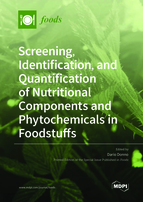Screening, Identification, and Quantification of Nutritional Components and Phytochemicals in Foodstuffs
A special issue of Foods (ISSN 2304-8158). This special issue belongs to the section "Food Analytical Methods".
Deadline for manuscript submissions: closed (10 November 2020) | Viewed by 50881
Special Issue Editor
Interests: plant foods; agrifood application and its nutritional properties; analytical strategies for phytochemical and nutritional characterization
Special Issues, Collections and Topics in MDPI journals
Special Issue Information
Dear Colleagues,
The interest in nutritional components, bioactive compounds, and phytochemicals in potential functional foods continues to grow, powered by the identification of health-promoting properties and potential applications of nutraceutical substances. These products may range from isolated nutrients, agri-foods, dietary supplements, and diets to genetically engineered "designer" foods, herbal products, and processed foods.
In recent years, nutraceutical foods, food supplements, herbal preparations, plant foods, and derived-products have become very attractive to the food industry, prompting their use as replacements for synthetic chemicals and nutraceuticals, but neglected and underutilized plant resources are suffering from less attention and research, and their nutritional, economic, and socio-cultural potentials are not fully exploited: the identification and quantification of nutritional substances and bioactive compounds in foods and the evaluation of their biological activities are important to gauge their efficacy as dietary interventions and in healthy applications.
Dr. Dario Donno
Guest Editor
Manuscript Submission Information
Manuscripts should be submitted online at www.mdpi.com by registering and logging in to this website. Once you are registered, click here to go to the submission form. Manuscripts can be submitted until the deadline. All submissions that pass pre-check are peer-reviewed. Accepted papers will be published continuously in the journal (as soon as accepted) and will be listed together on the special issue website. Research articles, review articles as well as short communications are invited. For planned papers, a title and short abstract (about 100 words) can be sent to the Editorial Office for announcement on this website.
Submitted manuscripts should not have been published previously, nor be under consideration for publication elsewhere (except conference proceedings papers). All manuscripts are thoroughly refereed through a single-blind peer-review process. A guide for authors and other relevant information for submission of manuscripts is available on the Instructions for Authors page. Foods is an international peer-reviewed open access semimonthly journal published by MDPI.
Please visit the Instructions for Authors page before submitting a manuscript. The Article Processing Charge (APC) for publication in this open access journal is 2900 CHF (Swiss Francs). Submitted papers should be well formatted and use good English. Authors may use MDPI's English editing service prior to publication or during author revisions.
Keywords
- phytochemicals
- agrobiodiversity
- plant foods
- HPLC
- herbal preparations
- mass spectrometry
- health-promoting properties
- human nutrition
- analytical strategies
- natural antioxidants







